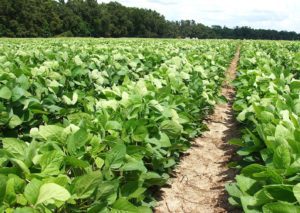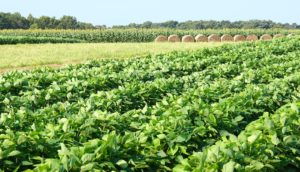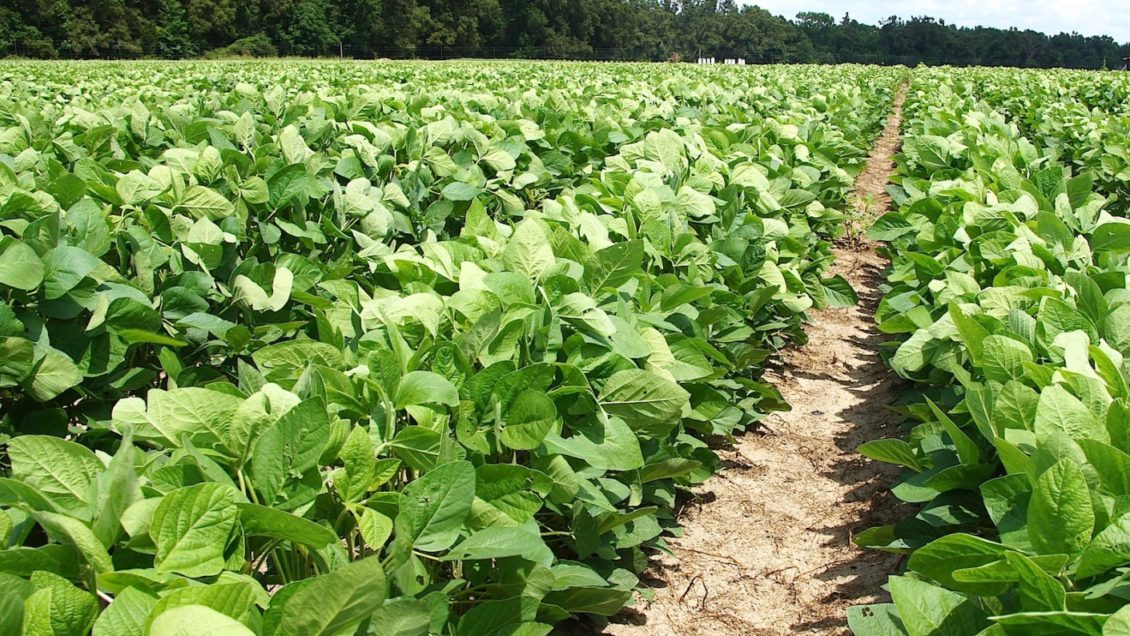BLACKVILLE, S.C. – Corn and soybean prices are rising which means more South Carolina farming acres could be allocated for these commodities.
During the 2021 Clemson Extension Corn and Soybean Meeting, held via Zoom, Clemson Extension corn and soybean specialist Michael Plumblee told participants 2020 was one of the “most productive years” for corn in South Carolina. Soybean acreage and yields for 2020 also were strong.
“If prices remain high, I expect we could see acreage split about even between corn, cotton and soybeans,” said Plumblee, who was named Clemson Cooperative Extension Service corn and soybean specialist in December. “Depending on what happens with fertilizer prices, corn acres may not go up quite as high as they would have, but we’re competing with soybean acres and with $14 per bushel soybeans, a price we have not seen in more than four years. Still, I do believe acreage for both commodities will increase compared with the past few years.”
South Carolina had one of the best-yielding corn crops ever in 2020. Information from the United States Department of Agriculture National Agricultural Statistics Service (USDA-NASS) for 2020 shows 400,000 acres of corn were planted, yielding an average of 132 bushels per acre.
A total of 310,000 acres of soybeans were planted, yielding an average of 35 bushels per acre and 190,000 acres of cotton were planted yielding an average of 778 pounds per acre.
Much of the state’s corn and soybean acreage is located on dryland. Timely rains helped create historical yields for farmers in 2020. To help farmers hopefully continue this trend, Plumblee said the Clemson Soybean Production Guide is being updated for 2021 and will be available online soon. An updated Corn Production Guide is anticipated to be available at the beginning of 2022.

Plumblee also talked about soil temperature recommendations for planting corn, as well as corn and soybean Official Variety Tests (OVT) data available online and the county corn hybrid demonstrations that will be planted across the state. Enterprise budgets are now available online from the Clemson Extension agribusiness team.
“If you’re still making decisions on what hybrids or varieties you’re going to select for your farm I highly recommend you look at the variety tests data and use the enterprise budgets to help you make some of your decisions on what you’re going to plant this year,” said Plumblee who is housed at the Edisto Research and Education Center (REC).
About 150 people attended the two virtual meetings Plumblee organized.
As for current commodity prices, Nathan Smith, director of the Clemson Extension agribusiness team located at the Sandhill REC, said new crop cotton has been trading in the 78 to 80 cent per pound range. April 7 trading was slightly above 80 cents per pound. Old-crop cotton was trading roughly the same but a little lower by about half a cent per pound.
Scott Mickey, farm business consultant and member of the agribusiness team, said the prospective plantings report indicated fewer acres than the trade was expecting. Corn and soybeans traded up last Wednesday (March 31) and have been easing higher this week (April 7). November beans are trading at $12.70 per bushel and December corn is at $4.86 per bushel.
“These are attractive prices for many South Carolina producers,” Mickey said.
Following Plumblee’s presentation, researchers from the Pee Dee Research and Education Center (REC) and Edisto REC discussed insects, diseases, weeds, and fertilizer options.
Bt corn helps control insects, protect environment
The European corn borer was once a threat for South Carolina corn growers, but since the arrival of Bt (Bacillus thuringiensis) corn, populations of this pest have waned to the point of no longer being a pest for now.
“European corn borers used to be abundant here in South Carolina,” said Francis Reay-Jones, Clemson entomologist and Integrated Pest Management program coordinator housed at the Pee Dee REC. “But in the 15 years that I’ve been here, I’ve yet to see one.”
European corn borer populations have declined over time, in part, because of the widespread use of Bt corn. Bt products farmers buy today contain two or three toxins, expanding the range of insects that are suppressed or controlled. Toxins in Bt corn target pests above ground as well as pests below ground known as rootworms. Because rootworms tend to be more of a problem where corn is planted year after year in the same fields, this insect is not a problem in the Southeast where corn commonly is planted as a rotation crop.

Fall armyworm and corn earworm are two insects controlled or suppressed by Bt toxins in South Carolina corn crops. Fall armyworms annually migrate to South Carolina from the Caribbean and southern Florida. This insect tends to show up late in the growing season.
The corn earworm creates its own set of problems. This insect is developing resistance to several Bt toxins. Resistance issues with Bt corn are leading to resistance issues in Bt cotton.
“Resistance is a major concern because, although corn is the preferred host, corn earworms also can attack cotton, where the insect is known as bollworm, as well as soybean and other host crops,” Reay-Jones said.
Stink bugs are probably the most significant economic pest of corn in South Carolina. Stink bugs are more of a problem in corn planted in no-till fields with heavy cover, corn growing in fields adjacent to wheat, in corn planted behind soybeans and in corn fields planted near woods.
Bifenthrin should be used for stink bug management in corn.
Soybean insects: stem feeders, defoliators, pod feeders
Many insects that create problems in corn also are problematic for soybeans. Jeremy Greene, a Clemson entomologist housed at the Edisto REC, said the most problematic species can be categorized as stem feeders, defoliators, or pod feeders.
“These insects don’t occur all season,” Greene said. “Some of them are problematic during a specific window. We usually deal with these insects during a particular part of the season, so that’s helpful.”
Insecticides, specifically pyrethroids, are effective in helping control stem feeders such as the threecornered alfalfa hopper and kudzu bugs. In addition, Greene believes early management could be beneficial in controlling the threecornered alfalfa hopper. Kudzu bugs have made a rebound in recent years, after significant suppression by natural enemies and Mother Nature. Treatment thresholds for these stem feeders are listed in the Clemson Pest Management Handbook.
Treatment thresholds for defoliators, such as grasshopper, soybean looper, green cloverworm, and velvetbean caterpillar, are 30% defoliation before mid-bloom and 15% defoliation after mid-bloom. Greene advises growers to start stamping out grasshoppers early as they are “difficult to control, especially when they are large.” Use 2 ounces of Dimilin per acre to treat for grasshopper nymphs, especially if the stand is threatened early. Dry conditions and minimum tillage operations favor grasshopper reproduction.
Soybean growers also should map out an attack plan for pod feeders, such as stink bugs and podworm. Insecticides, particularly pyrethroids, are effective against stink bugs, and Greene said thresholds should be set at 1 stink bug per row foot or 1-2 stink bugs per 10 sweeps.
Podworm, also known as the corn earworm or bollworm also targets pods and seeds and is becoming more difficult to control with pyrethroids, often requiring similar insecticides as used to control the soybean looper.
Bt soybeans on the horizon?
Genetic engineering of crops has been combined with selective breeding and cross-breeding to select for plants with more desirable traits for decades. Information from the National Center for Biotechnology Information (NCBI) shows in 1911, German scientist Ernst Berliner isolated a bacterium he called Bacillus thuringiensis (Bt) from flour moth caterpillars. It was soon determined the bacterium was specifically toxic to certain insect groups and not others. In the 1920s, Bt was harnessed as a tool for pest control and, since the mid-1990s, corn and cotton have been engineered to produce toxic Bt proteins in commercially available varieties.
Clemson researchers have been testing Bt soybeans at the Edisto REC since 2013. Greene said the product being tested is “very good at controlling caterpillar insects and could be available in the United States within the next few years.”
Weed updates
Weeds are a problem for many farmers and the popular corn herbicide atrazine recently completed its review for re-registration.
“Atrazine is a very inexpensive, foundation herbicide that has been used in corn herbicide programs for years in South Carolina,” said Mike Marshall, Clemson Extension weed specialist, also housed at the Edisto REC. “Although a very popular herbicide, atrazine’s soil residual efficacy on weeds has decreased over time which means additional herbicides are needed for corn weed management.”
For later season weed problems, there are several options for corn including Aim, Glyphosate, Paraquat and 2,4-D amine for preharvest; and Glyphosate, Paraquat and 2,4-D amine for post-harvest.
For weed control in soybeans, Marshall said Xtendimax, Tavium and Engenia were granted new 5-year labels in Fall 2020, adding South Carolina is applying for a 24c label for these dicamba herbicides. XtendFlex soybeans were approved in 2020. These soybeans are tolerant to dicamba, glyphosate and glufosinate (Liberty).
Control nematodes and use correct fertilizer options
In talking about diseases and nematodes, John Mueller, Clemson plant pathologist at the Edisto REC, said stubby root nematodes on corn has become a big issue in recent years. Researchers are trying to determine why this increase has happened.
“Using nematicides is our best control option right now along with avoiding planting corn continuously in the same field,” Mueller said.
Farmers who use the nematicide Counter 20G at 6.5 pounds per acre should avoid using ALS (acetolactate synthase) herbicides at planting or run the risk of phytotoxicity. Seed treatment nematicides are available and other nematicides such as Propulse and Velum can be applied in-furrow. Corn can be an effective rotation crop to help control soybean cyst nematode and reniform nematode on other crops.
“We do have some options when it comes to nematicides,” he said, “But first, get out and sample your fields to make sure you have a nematode problem and then we’ll devise a strategy to deal with it.”
Foliar disease is another issue on corn. Mueller said early season problems with Physoderma brown spot and stalk rot have been seen in recent years. Avoiding continuously planting corn in the same field will help control this disease. Farmers who use a fungicide to control Physoderma brown spot and stalk rot must apply it early in the growing season, preferably in-furrow, at-planting. Applying a fungicide just before tasseling will be too late to control Physoderma brown spot. Other foliar diseases include: Northern Corn Leaf Spot, Gray Leaf Spot, Northern Corn Leaf Blight, Southern Corn Leaf Blight, Common Rust and Southern Rust. Resistance varieties are available to several of these diseases and should be the first control option. Mueller says to check the varieties you want to buy to be sure they have resistance.
In a discussion on fertility, Bhupinder Farmaha, Clemson soil nutrient management specialist from the Edisto REC, said nitrogen, phosphorus, and potassium are important elements for corn and soybeans.
“We must keep in mind that we do need to have a good fertility program to raise high-yielding crops for both corn and beans,” Farmaha said.
A good soil sampling strategy is essential to accurately assess the field’s nutrient status, apply lime to balance pH and supply adequate nutrients through fertilizers to raise high-yielding corn and soybean. Farmers should also use plant tissue testing during the growing season to correct any nutrient deficiencies. It is highly recommended to frequently do sub-soil testing when depth to the hardpan is no greater than 20 inches and disrupted by in-row subsoiling.
Fertilizer application rates should be adjusted based on sub-soil nutrient reserves, especially for phosphorus and potassium. Nitrogen recommendations for corn in South Carolina are based on yield goals. Therefore, it is essential to set realistic yield goals based on field history, Farmaha said.
-END-
Get in touch and we will connect you with the author or another expert.
Or email us at news@clemson.edu

